Leaf Thermal and Chemical Properties as Natural Drivers of Plant Flammability of Native and Exotic Tree Species of the Valparaíso Region, Chile
Abstract
:1. Introduction
2. Materials and Methods
2.1. Study Area and Leaf Sampling
2.2. Flammability Measurements
2.3. Heat of Combustion
2.4. Flash Point
2.5. Chemical Extraction and Analysis
2.6. Moisture Content
2.7. Data Analysis
3. Results
3.1. Ignition Time
3.2. Flame Duration
3.3. Burning Time
3.4. Flammability Index
3.5. Heat of Combustion
3.6. Flash Point
3.7. Moisture Content
3.8. Essential Oils and Identification of Terpenes/Other Chemical Compounds in Leaves
3.9. Relationship between Thermochemical Parameters and Natural Drivers of the Leaves
4. Discussion
4.1. Variation in Flammability of Forest Species
4.2. Variation of Heating Values
4.3. Drivers of Leaf Flammability: Essential Oils, Chemical Compounds, and Moisture Content
5. Conclusions
Supplementary Materials
Author Contributions
Funding
Institutional Review Board Statement
Informed Consent Statement
Data Availability Statement
Acknowledgments
Conflicts of Interest
References
- Costafreda-Aumedes, S.; Comas, C.; Vega-Garcia, C. Human-caused fire occurrence modelling in perspective: A review. Int. J. Wildl. Fire 2017, 26, 983–998. [Google Scholar] [CrossRef]
- Reisen, F.; Duran, S.M.; Flannigan, M.; Elliott, C.; Rideout, K. Wildfire smoke and public health risk. Int. J. Wildl. Fire 2015, 24, 1029–1044. [Google Scholar] [CrossRef]
- Cascio, W.E. Wildland fire smoke and human health. Sci. Total. Environ. 2018, 624, 586–595. [Google Scholar] [CrossRef] [PubMed]
- Fann, N.; Alman, B.; Broome, R.A.; Morgan, G.G.; Johnston, F.H.; Pouliot, G.; Rappold, A.G. The health impacts and economic value of wildland fire episodes in the U.S.: 2008–2012. Sci. Total Environ. 2018, 610–611, 802–809. [Google Scholar] [CrossRef] [PubMed]
- Finlay, S.; Moffat, A.J.; Gazzard, R.; Baker, D.; Murray, V. Wildfires and Health Impacts. PLoS Curr. Disasters 2012. [Google Scholar] [CrossRef] [PubMed]
- Guerrero, F.; Toledo, M.; Ripoll, N.; Espinoza, L.; Morales, R.; Muñoz, A.; Taborga, L.; Carrasco, Y. Thermo-and physicochemical properties of native and exotic forest species of Valparaíso, Chile, as essential information for fire risk management. Int. J. Wildl. Fire 2020, 29, 675–685. [Google Scholar] [CrossRef]
- Hodzic, A.; Madronich, S.; Bonn, B.; Massie, S.; Menut, L.; Wiedinmyer, C. Wildfire particulate matter in Europe during summer 2003: Meso-scale modeling of smoke emissions, transport and radiative effects. Atmos. Chem. Phys. 2007, 7, 4043–4064. [Google Scholar] [CrossRef] [Green Version]
- Sitch, S.; Cox, P.M.; Collins, W.J.; Huntingford, C. Indirect radiative forcing of climate change through ozone effects on the land-carbon sink. Nature 2007, 448, 791–794. [Google Scholar] [CrossRef] [PubMed]
- Miranda, A.I. An integrated numerical system to estimate air quality effects of forest fires. Int. J. Wildl. Fire 2004, 13, 217–226. [Google Scholar] [CrossRef]
- Green, B.L. Evaluating the Effects of Disasters. Psychol. Assess. 1991, 3, 538–546. [Google Scholar] [CrossRef]
- Ojeda, C.G.; Jaque Castillo, E.; Fernández Castillo, S. Postwildfire Landscape Identity in Mediterranean Ecosystems: Three Study Cases from the Coastal Range of Central Chile. Ann. Am. Assoc. Geogr. 2021, 1–14. [Google Scholar] [CrossRef]
- Carmona, C.P.; Azcárate, F.M.; de Bello, F.; Ollero, H.S.; Lepš, J.; Peco, B. Taxonomical and functional diversity turnover in Mediterranean grasslands: Interactions between grazing, habitat type and rainfall. J. Appl. Ecol. 2012, 49, 1084–1093. [Google Scholar] [CrossRef]
- Keeley, J.E.; Bond, W.J.; Bradstock, R.A.; Pausas, J.G.; Rundel, P.W. Fire in Mediterranean Ecosystems; Cambridge University Press: Cambridge, UK, 2011; pp. 398–497. [Google Scholar]
- Turco, M.; Von Hardenberg, J.; AghaKouchak, A.; Llasat, M.C.; Provenzale, A.; Trigo, R.M. On the key role of droughts in the dynamics of summer fires in Mediterranean Europe. Sci. Rep. 2017, 7, 1–10. [Google Scholar] [CrossRef] [Green Version]
- Smith, C.W.; Panda, S.K.; Bhatt, U.S.; Meyer, F.J. Improved boreal forest wildfire fuel type mapping in interior alaska using aviris-ng hyperspectral data. Remote Sens. 2021, 13, 897. [Google Scholar] [CrossRef]
- CALFIRE California Department of Forestry and Fire Protection. Available online: https://calfire.ca.gov (accessed on 10 April 2019).
- Goss, M.; Swain, D.L.; Abatzoglou, J.T.; Sarhadi, A.; Kolden, C.A.; Williams, A.P.; Diffenbaugh, N.S. Climate change is increasing the likelihood of extreme autumn wildfire conditions across California. Environ. Res. Lett. 2020, 15, 094016. [Google Scholar] [CrossRef] [Green Version]
- Yu, P.; Xu, R.; Abramson, M.J.; Li, S.; Guo, Y. Bushfires in Australia: A serious health emergency under climate change. Lancet Planet Heal. 2020, 4, e7–e8. [Google Scholar] [CrossRef] [Green Version]
- Soto, M.C.; Julio-Alvear, G.; Salinas, R.G. Current Wildfire Risk Status and Forecast in Chile: Progress and Future Challenges. In Wildfire Hazards, Risks, and Disasters; Shroder, J.F., Paton, D., Eds.; Elsevier Inc.: Amsterdam, The Netherlands, 2015; pp. 59–75. ISBN 9780124096011. [Google Scholar]
- Vicencio, J.; Cortés, C.; Campos, D.E.; Tudela, V. Informe Climático Especial Enero 2017: Un mes de récords. Sección Meteorología Agrícola. Sección Climatología; Dirección Meteorológica de Chile; Subdepartamento de Climatología y Meteorología Aplicada, 2017; p. 13. Available online: http://blog.meteochile.gob.cl/wp-content/uploads/2017/12/informe_enero.pdf (accessed on 10 March 2021).
- De la Barrera, F.; Barraza, F.; Favier, P.; Ruiz, V.; Quense, J. Megafires in Chile 2017: Monitoring multiscale environmental impacts of burned ecosystems. Sci. Total Environ. 2018, 637–638, 1526–1536. [Google Scholar] [CrossRef]
- FAO—Food and Agriculture Organization Wildfire Prevention in the Mediterranean. 2011. Available online: http://www.fao.org/3/i2495e/i2495e00.htm (accessed on 10 March 2021).
- CONAF Incendios Forestales en Chile, Estadísticas Históricas: Resumen Nacional y Regional de Ocurrencia (Número) y Daño (Superficie Afectada) por Incendios Forestales. 1964–2019. Available online: www.conaf.cl/incendios-forestales/incendios-forestales-en-chile/estadisticas-historicas/ (accessed on 10 June 2021).
- Bowman, D.M.J.S.; Moreira-Muñoz, A.; Kolden, C.A.; Chávez, R.O.; Muñoz, A.A.; Salinas, F.; González-Reyes, Á.; Rocco, R.; de la Barrera, F.; Williamson, G.J.; et al. Human–environmental drivers and impacts of the globally extreme 2017 Chilean fires. Ambio 2019, 48, 350–362. [Google Scholar] [CrossRef]
- CONAF Fondo de Investigación del Bosque Nativo Aporta a la Recuperación del Bosque Esclerófilo. Available online: www.conaf.cl/fondo-de-investigacion-del-bosque-nativo-aporta-a-la-recuperacion-del-bosque-esclerofilo/ (accessed on 10 June 2021).
- CONAF Controlan Extenso Incendio Forestal Que Afectó a Valparaíso y Quilpué. Available online: www.conaf.cl/controlan-extenso-incendio-forestal-que-afecto-a-valparaiso-y-quilpue/ (accessed on 10 March 2021).
- Bowman, D.M.J.S.; Williamson, G.J.; Abatzoglou, J.T.; Kolden, C.A.; Cochrane, M.A.; Smith, A.M.S. Human exposure and sensitivity to globally extreme wildfire events. Nat. Ecol. Evol. 2017, 1, 1–6. [Google Scholar] [CrossRef]
- Garreaud, R.D.; Boisier, J.P.; Rondanelli, R.; Montecinos, A.; Sepúlveda, H.H.; Veloso-Aguila, D. The Central Chile Mega Drought (2010–2018): A climate dynamics perspective. Int. J. Climatol. 2020, 40, 421–439. [Google Scholar] [CrossRef]
- Castellnou, M.; Álvarez, R.; Almodóvar, J.; Martins, F.; Mayoral, P.C.; Alfonso, L.; Basile, G. Informe Técnico: Situación de Incendios Forestales en Chile entre Enero-Febrero 2017; European Union Civil Protection Mechanism: Luxembourg, 2017; p. 11. [Google Scholar]
- Garreaud, R.D.; Alvarez-Garreton, C.; Barichivich, J.; Pablo Boisier, J.; Christie, D.; Galleguillos, M.; LeQuesne, C.; McPhee, J.; Zambrano-Bigiarini, M. The 2010-2015 megadrought in central Chile: Impacts on regional hydroclimate and vegetation. Hydrol. Earth Syst. Sci. 2017, 21, 6307–6327. [Google Scholar] [CrossRef] [Green Version]
- CEPAL. La economía del cambio climático en Chile. Com. Economica America Lat. Caribe 2012, 367, LC/W.472. Available online: http://hdl.handle.net/11362/35372 (accessed on 10 March 2021).
- Araya-Osses, D.; Casanueva, A.; Román-Figueroa, C.; Uribe, J.M.; Paneque, M. Climate change projections of temperature and precipitation in Chile based on statistical downscaling. Clim. Dyn. 2020, 54, 4309–4330. [Google Scholar] [CrossRef]
- Urrutia-Jalabert, R.; González, M.E.; González-Reyes, Á.; Lara, A.; Garreaud, R. Climate variability and forest fires in central and south-central Chile. Ecosphere 2018, 9, e02171. [Google Scholar] [CrossRef]
- Anderson, H.E. Forest fuel ignitibility. Fire Technol. 1970, 6, 312–319. [Google Scholar] [CrossRef]
- Martin, R.E.; Gordon, D.A.; Gutierrez, M.A.; Lee, D.S.; Domingo, M.M.T.; Schroeder, R.A.; Sapsis, D.B.; Stephens, S.L. Assessing the Flammability of Domestic and Wildland Vegetation. In Proceedings of the 12th Conference of Fire and Forest Meteorology, Jekyll Island, GA, USA, 26–28 October 1993; pp. 26–28. [Google Scholar] [CrossRef]
- White, R.H.; Zipperer, W.C. Testing and classification of individual plants for fire behaviour: Plant selection for the wildlandurban interface. Int. J. Wildl. Fire 2010, 19, 213–227. [Google Scholar] [CrossRef]
- Valette, J.-C. Inflammabilités des espèces forestières méditerranéennes: Conséquences sur la combustibilité des formations forestières. Rev. For. Fr. 1990, 42, 76–92. [Google Scholar] [CrossRef] [Green Version]
- Ormeño, E.; Céspedes, B.; Sánchez, I.A.; Velasco-García, A.; Moreno, J.M.; Fernandez, C.; Baldy, V. The relationship between terpenes and flammability of leaf litter. For. Ecol. Manag. 2009, 257, 471–482. [Google Scholar] [CrossRef]
- Hachmi, M.; Sesbou, A.; Benjelloun, H.; El Handouz, N.; Bouanane, F. A simple technique to estimate the flammability index of moroccan forest fuels. J. Combust. 2011, 2011, 1–11. [Google Scholar] [CrossRef]
- Batista, A.; Biondi, D.; Tetto, A.; Assunção, R. De Evaluación de la Inflamabilidad de Árboles y Arbustos Utilizados en la Implementación de Barreras Verdes en el Sur del Brasil. In Proceedings of the Fourth International Symposium on Fire Economics, Planning, and Policy: Climate Change and Wildfires, Mexico, USA, 5–11 November 2021; Department of Agriculture, Forest Service, Pacific Southwest Research Station: Albany, CA, USA, 2012; pp. 278–286. [Google Scholar]
- Frejaville, T.; Curt, T.; Carcaillet, C. Bark flammability as a fire-response trait for subalpine trees. Front. Plant Sci. 2013, 4, 1–9. [Google Scholar] [CrossRef] [Green Version]
- Della Rocca, G.; Madrigal, J.; Marchi, E.; Michelozzi, M.; Moya, B.; Danti, R. Relevance of terpenoids on flammability of Mediterranean species: An experimental approach at a low radiant heat flux. IForest Biogeosci. For. 2017, 10, 766–775. [Google Scholar] [CrossRef] [Green Version]
- Rodríguez, Y.C.; Rodríguez, M.P.R.; Mesa, F.J.; Hernández, Y.C.; Becerra, L.W.M. Inflamabilidad de especies vegetales del ecosistema de pinares. Rev. Cuba. Ciencias For. 2016, 4, 36–47. [Google Scholar]
- Molina, J.R.; Martín, T.; Rodríguez, Y.; Silva, F.; Herrera, M.Á. The ignition index based on flammability of vegetation improves planning in the wildland-urban interface: A case study in Southern Spain. Landsc. Urban Plan. 2017, 158, 129–138. [Google Scholar] [CrossRef]
- Ganteaume, A. Does plant flammability differ between leaf and litter bed scale? Role of fuel characteristics and consequences for flammability assessment. Int. J. Wildl. Fire 2018, 27, 342–352. [Google Scholar] [CrossRef] [Green Version]
- Blackhall, M.; Raffaele, E. Flammability of Patagonian invaders and natives: When exotic plant species affect live fine fuel ignitability in wildland-urban interfaces. Landsc. Urban Plan. 2019, 189, 1–10. [Google Scholar] [CrossRef]
- Massari, G.; Leopaldi, A. Leaf flammability in mediterranean species. Plant Biosyst. 2013, 132, 29–38. [Google Scholar] [CrossRef]
- Prior, L.D.; Murphy, B.P.; Bowman, D.M.J.S. Conceptualizing ecological flammability: An experimental test of three frameworks using various types and loads of surface fuels. Fire 2018, 1, 14. [Google Scholar] [CrossRef] [Green Version]
- Schwilk, D.W. Dimensions of plant flammability. New Phytol. 2015, 206, 486–488. [Google Scholar] [CrossRef]
- Pausas, J.G.; Keeley, J.E.; Schwilk, D.W. Flammability as an ecological and evolutionary driver. J. Ecol. 2017, 105, 289–297. [Google Scholar] [CrossRef]
- Ramos, M.P. Manejo del Fuego; Editorial Félix Varela: La Habana, Cuba, 2010; ISBN 978-959-07-1322-4. [Google Scholar]
- Elvira, M.; Luis, M. Inflamabilidad y Energía de las Especies de Sotobosque. (Estudio Piloto con Aplicación a los Incendios Forestales); Instituto Nacional de Investigaciones Agrarias: Madrid, Spain, 1989; ISBN 84-7498-341-X. [Google Scholar]
- Morgan Varner, J.; Kane, J.M.; Kreye, J.K.; Engber, E. The flammability of forest and woodland litter: A synthesis. Curr. For. Rep. 2015, 1, 91–99. [Google Scholar] [CrossRef]
- Nuňez-Regueira, L.; Rodríguez-Aňón, J.A.; Proupín, J.; Mouriňo, B.; Artiaga-Diaz, R. Energetic study of residual forest biomass using calorimetry and thermal analysis. J. Therm. Anal. Calorim. 2005, 80, 457–464. [Google Scholar] [CrossRef]
- Owens, M.K.; Lin, C.D.; Taylor, C.A.; Whisenant, S.G. Seasonal patterns of plant flammability and monoterpenoid content in Juniperus ashei. J. Chem. Ecol. 1998, 24, 2115–2129. [Google Scholar] [CrossRef]
- Page, S.E.; Siegert, F.; Rieley, J.O.; Boehm, H.D.V.; Jaya, A.; Limin, S. The amount of carbon released from peat and forest fires in Indonesia during 1997. Nature 2002, 420, 61–65. [Google Scholar] [CrossRef]
- Pausas, J.G.; Alessio, G.A.; Moreira, B.; Segarra-Moragues, J.G. Secondary compounds enhance flammability in a Mediterranean plant. Oecologia 2016, 180, 103–110. [Google Scholar] [CrossRef] [PubMed] [Green Version]
- Bettinger, P. An overview of methods for incorporating wildfires into forest planning models. Math. Comput. For. Nat. Resour. Sci. 2010, 2, 43–52. [Google Scholar]
- Castillo, M.E.; Molina, J.R.; Rodríguez y Silva, F.; García-Chevesich, P.; Garfias, R. A system to evaluate fire impacts from simulated fire behavior in Mediterranean areas of Central Chile. Sci. Total Environ. 2017, 579, 1410–1418. [Google Scholar] [CrossRef]
- Fernández, I.; Morales, N.; Olivares, L.; Salvatierra, J.; Gómez, M.; Montenegro, G. Restauración ecológica para ecosistemas nativos afectados por incendios forestales. Rev. Chil. Hist. Nat. 2010, 461–462. [Google Scholar]
- Miguel, C.S.; Roberto, G.S.; Guillermo, J.A.; Luis, G.R. Análisis de grandes incendios forestales en la vegetación nativa de Chile. Interciencia 2012, 37, 796–804. [Google Scholar]
- Soto, M.E.C.; Molina-Martínez, J.R.; Rodríguez y Silva, F.; Alvear, G.H.J. A territorial fire vulnerability model for Mediterranean ecosystems in South America. Ecol. Inform. 2013, 13, 106–113. [Google Scholar] [CrossRef]
- Castillo, M.S.; Plaza, V.Á.; Garfias, S.R. A recent review of fire behavior and fire effects on native vegetation in Central Chile. Glob. Ecol. Conserv. 2020, 24, e01210. [Google Scholar] [CrossRef]
- CONAF. Índice de Probabilidad de Ignición. Available online: www.conaf.cl/incendios-forestales/combate-de-incendios-forestales/indice-de-probabilidad-de-ignicion/ (accessed on 10 June 2021).
- Hauenstein, E.; Muñoz-Pedreros, A.; Yánez, J.; Sánchez, P.; Möller, P.; Guiñez, B.; Gil, C. Flora y vegetación de la Reserva Nacional Lago Peñuelas, Reserva de la Biósfera, Región de Valparaíso, Chile. Bosque 2009, 30, 159–179. [Google Scholar] [CrossRef] [Green Version]
- Dirección General De Aeronáutica Civil. Oficina de Servicios Climáticos. Available online: https://climatologia.meteochile.gob.cl/ (accessed on 10 December 2020).
- Pickett, B.M.; Isackson, C.; Wunder, R.; Fletcher, T.H.; Butler, B.W.; Weise, D.R. Flame interactions and burning characteristics of two live leaf samples. Int. J. Wildl. Fire 2009, 18, 865–874. [Google Scholar] [CrossRef]
- McCaw, W.L.; Neal, J.E.; Smith, R.H. Fuel accumulation following prescribed burning in young even-aged stands of karri (eucalyptus diversicolor). Aust. For. 1996, 59, 171–177. [Google Scholar] [CrossRef]
- Krix, D.W.; Murray, B.R. Landscape variation in plant leaf flammability is driven by leaf traits responding to environmental gradients. Ecosphere 2018, 9, e02093. [Google Scholar] [CrossRef]
- Krix, D.W.; Phillips, M.L.; Murray, B.R. Relationships among leaf flammability attributes and identifying low-leaf-flammability species at the wildland-urban interface. Int. J. Wildl. Fire 2019, 28, 295–297. [Google Scholar] [CrossRef]
- Azcón, J.; Fleck, I.; Aranda, X.; Gómez, N. Fotosintesis, factores ambientales. Fundam. Fisologia Veg. 2008, 247–263. [Google Scholar]
- Restrepo, H.; Volder, A.; Lombardini, L. Caracterización morfológica y fisiológica de hojas de luz y de sombra en nogal pacanero. J. Am. Soc. Hortic. Sci. 2009, 134, 372–3748. [Google Scholar]
- Ormeño, E.; Ruffault, J.; Gutigny, C.; Madrigal, J.; Guijarro, M.; Hernando, C.; Ballini, C. Increasing cuticular wax concentrations in a drier climate promote litter flammability. For. Ecol. Manag. 2020, 473, 118242. [Google Scholar] [CrossRef]
- Ganteaume, A.; Jappiot, M.; Lampin, C.; Guijarro, M.; Hernando, C. Flammability of some ornamental species in wildland-urban interfaces in southeastern France: Laboratory assessment at particle level. Environ. Manag. 2013, 52, 467–480. [Google Scholar] [CrossRef] [PubMed] [Green Version]
- ASTM. ASTM D240-00 Standard Test Method for Heat of Combustion of Liquid Hydrocarbon Fuels by Bomb Calorimeter; ASTM International: West Conshohocken, PA, USA, 2000. [Google Scholar]
- ASTM. ASTM D-92-72 Standard Test Method for Flash and Fire Points by Cleveland Open Cup; ASTM International: West Conshohocken, PA, USA, 1972. [Google Scholar]
- Ormeño, E.; Goldstein, A.; Niinemets, Ü. Extracting and trapping biogenic volatile organic compounds stored in plant species. TrAC Trends Anal. Chem. 2011, 30, 978–989. [Google Scholar] [CrossRef]
- Wu, C.; Wang, F.; Liu, J.; Zou, Y.; Chen, X. A comparison of volatile fractions obtained from Lonicera macranthoides via different extraction processes: Ultrasound, microwave, Soxhlet extraction, hydrodistillation, and cold maceration. Integr. Med. Res. 2015, 4, 171–177. [Google Scholar] [CrossRef] [Green Version]
- Gonçalves, D.; Koshima, C.C.; Nakamoto, K.T.; Umeda, T.K.; Aracava, K.K.; Gonçalves, C.B.; Rodrigues, C.E.D.C. Deterpenation of eucalyptus essential oil by liquid + liquid extraction: Phase equilibrium and physical properties for model systems at T = 298.2 K. J. Chem. Thermodyn. 2014, 69, 66–72. [Google Scholar] [CrossRef]
- Jiang, J. Volatile composition of the laksa plant (Polygonum hydropiper L.), a potential source of green note aroma compounds. Flavour Fragr. J. 2005, 20, 455–459. [Google Scholar] [CrossRef]
- Van Den Dool, H.; Kratz, P.D. A generalization of the retention index system including linear temperature programmed gas—liquid partition chromatography. J. Chromatogr. A 1963, 11, 463–471. [Google Scholar] [CrossRef]
- Peter, G. Waterman Identification of essential oil components by gas chromatography. Biochem. Syst. Ecol. 1996, 24, 594. [Google Scholar]
- Behm, A.L.; Duryea, M.L.; Long, A.J.; Zipperer, W.C. Flammability of native understory species in pine flatwood and hardwood hammock ecosystems and implications for the wildland-urban interface. Int. J. Wildl. Fire 2004, 13, 355–365. [Google Scholar] [CrossRef] [Green Version]
- Bianchi, L.O.; Oddi, F.J.; Muñoz, M.; Defossé, G.E. Comparison of leaf moisture content and ignition characteristics among native species and exotic conifers in Northwestern Patagonia, Argentina. For. Sci. 2019, 65, 375–386. [Google Scholar] [CrossRef]
- Romero, B.; Fernandez, C.; Lecareux, C.; Ormeño, E.; Ganteaume, A. How terpene content affects fuel flammability of wildland-urban interface vegetation. Int. J. Wildl. Fire 2019, 28, 614–627. [Google Scholar] [CrossRef] [Green Version]
- Programa de las Naciones Unidas para el Desarrollo (PNUD) Objetivos de Desarrollo Sostenible (ODS). Available online: www1.undp.org/content/undp/es/home/sustainable-development-goals.html. (accessed on 10 June 2021).
- Ganteaume, A.; Guijarro, M.; Jappiot, M.; Hernando, C.; Lampin-Maillet, C.; Pérez-Gorostiaga, P.; Vega, J.A. Laboratory characterization of firebrands involved in spot fires. Ann. For. Sci. 2011, 68, 531–541. [Google Scholar] [CrossRef] [Green Version]
- Nunes, A.N.; Lourenço, L.; Meira, A.C.C. Exploring spatial patterns and drivers of forest fires in Portugal (1980–2014). Sci. Total Environ. 2016, 573, 1190–1202. [Google Scholar] [CrossRef] [PubMed]
- Rodríguez Rivas, A. Estudios de Valoración Energética de Combustibles Forestales para la Prevención de Incendios Forestales en la Sierra de la Primavera (Jalisco, México) Mediante Calorimetría de Combustión y Ensayos de Inflamabilidad; Universidad de Santiago de Compostela: Santiago de Compostela, Spain, 2009; p. 123. [Google Scholar]
- Ormeño, E.; Fernandez, C.; Mévy, J.P. Plant coexistence alters terpene emission and content of Mediterranean species. Phytochemistry 2007, 68, 840–852. [Google Scholar] [CrossRef]
- Dimitrakopoulos, A.P.; Papaioannou, K.K. Flammability Assessment of Mediterranean Forest Fuels. Fire Tech. 2001, 37, 143–152. [Google Scholar] [CrossRef]
- Vecchio, M.G.; Loganes, C.; Minto, C. Beneficial and Healthy Properties of Eucalyptus Plants: A Great Potential Use. Open Agric. J. 2016, 10, 52–57. [Google Scholar] [CrossRef] [Green Version]
- Nowak, D.J.; Crane, D.E.; Stevens, J.C.; Ibarra, M. Brooklyn’s Urban Forest; General Technical Report NE-290; United States Department of Agriculture, Forest Service, North-Eastern Forest Experiment Station: Radnor, PA, USA, 2002; p. 107. [Google Scholar]
- Di Cosmo, D.; Santander, R.; Urzúa, A.; Palacios, S.M.; Rossi, Y. Insecticidal effect of Cryptocarya alba essential oil on the housefly, Musca domestica L. Bol. Latinoam. Caribe Plantas Med. Aromat. 2015, 14, 113–117. [Google Scholar]
- Bravo, J.; Carbonell, V.; Sepúlveda, B.; Delporte, C.; Valdovinos, C.E.; Martín-Hernández, R.; Higes, M. Antifungal activity of the essential oil obtained from Cryptocarya alba against infection in honey bees by Nosema ceranae. J. Invertebr. Pathol. 2017, 149, 141–147. [Google Scholar] [CrossRef] [PubMed]
- Murray, B.R.; Hardstaff, L.K.; Phillips, M.L. Differences in leaf flammability, leaf traits and flammability-trait relationships between native and exotic plant species of dry sclerophyll forest. PLoS ONE 2013, 8, e79205. [Google Scholar] [CrossRef] [Green Version]
- De Lillis, M.; Bianco, P.M.; Loreto, F. The influence of leaf water content and isoprenoids on flammability of some Mediterranean woody species. Int. J. Wildl. Fire 2009, 18, 203–212. [Google Scholar] [CrossRef]
- Dhifi, W.; Bellili, S.; Jazi, S.; Bahloul, N.; Mnif, W. Essential Oils’ Chemical Characterization and Investigation of Some Biological Activities : A critical Review. Medicines 2016, 3, 25. [Google Scholar] [CrossRef] [PubMed] [Green Version]
- Grootemaat, S.; Wright, I.J.; van Bodegom, P.M.; Cornelissen, J.H.C.; Cornwell, W.K. Burn or rot: Leaf traits explain why flammability and decomposability are decoupled across species. Funct. Ecol. 2015, 29, 1486–1497. [Google Scholar] [CrossRef] [Green Version]
- Jolly, W.M.; Parsons, R.A.; Hadlow, A.M.; Cohn, G.M.; McAllister, S.S.; Popp, J.B.; Hubbard, R.M.; Negron, J.F. Relationships between moisture, chemistry, and ignition of Pinus contorta needles during the early stages of mountain pine beetle attack. For. Ecol. Manag. 2012, 269, 52–59. [Google Scholar] [CrossRef]
- Qi, Y.; Jolly, W.M.; Dennison, P.E.; Kropp, R.C. Seasonal relationships between foliar moisture content, heat content and biochemistry of lodgepole line and big sagebrush foliage. Int. J. Wildl. Fire 2016, 25, 574–578. [Google Scholar] [CrossRef]
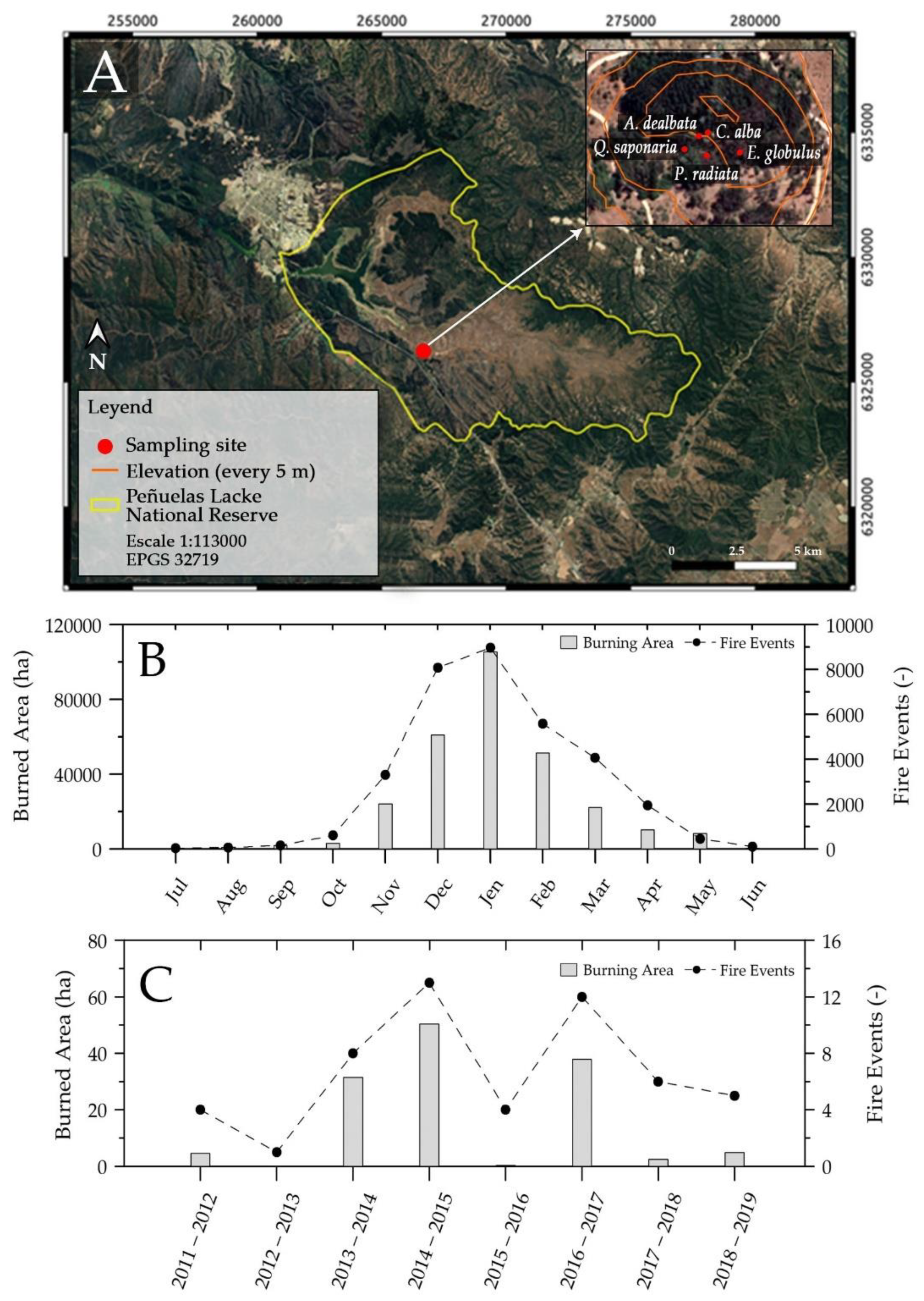
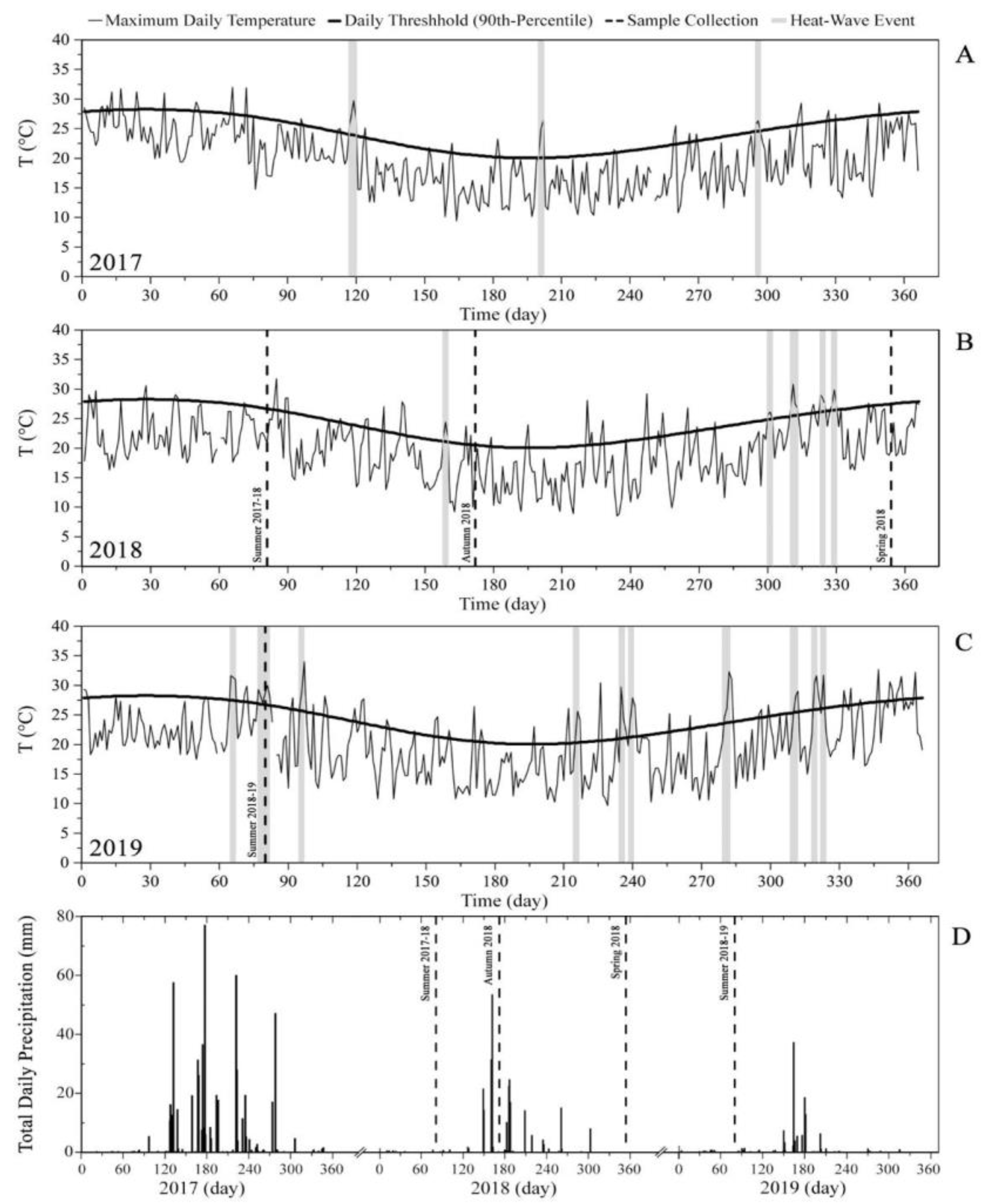
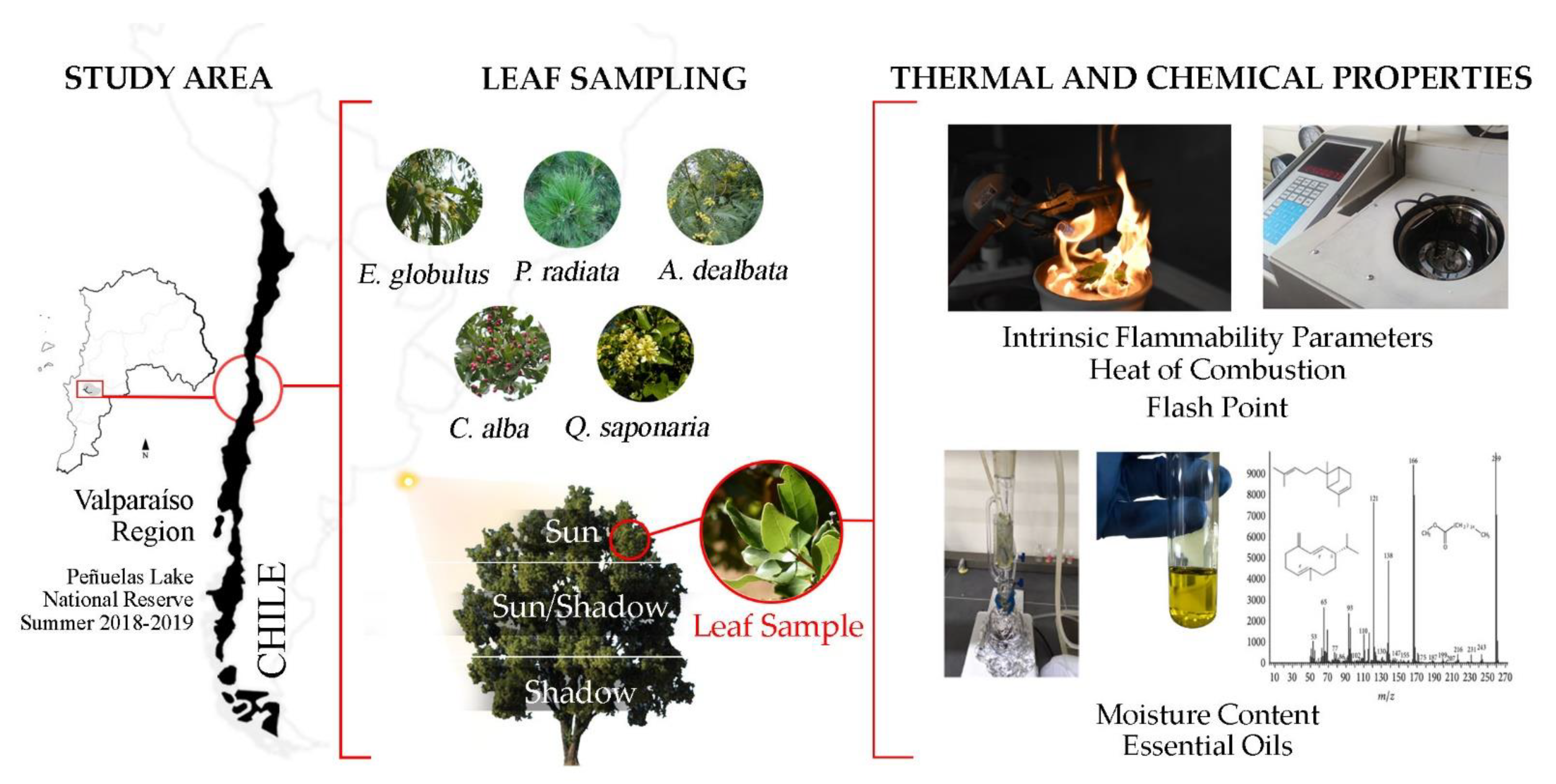
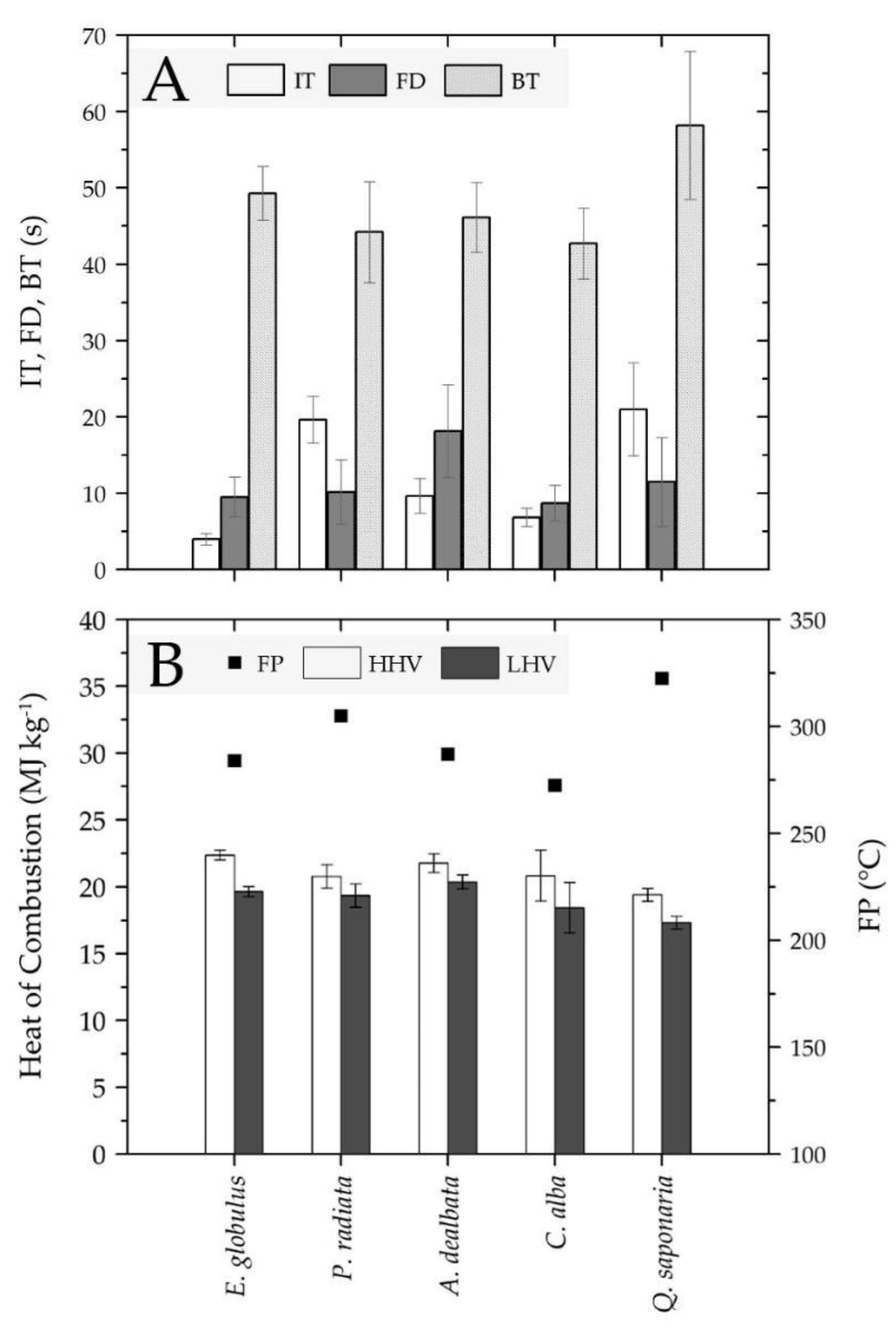
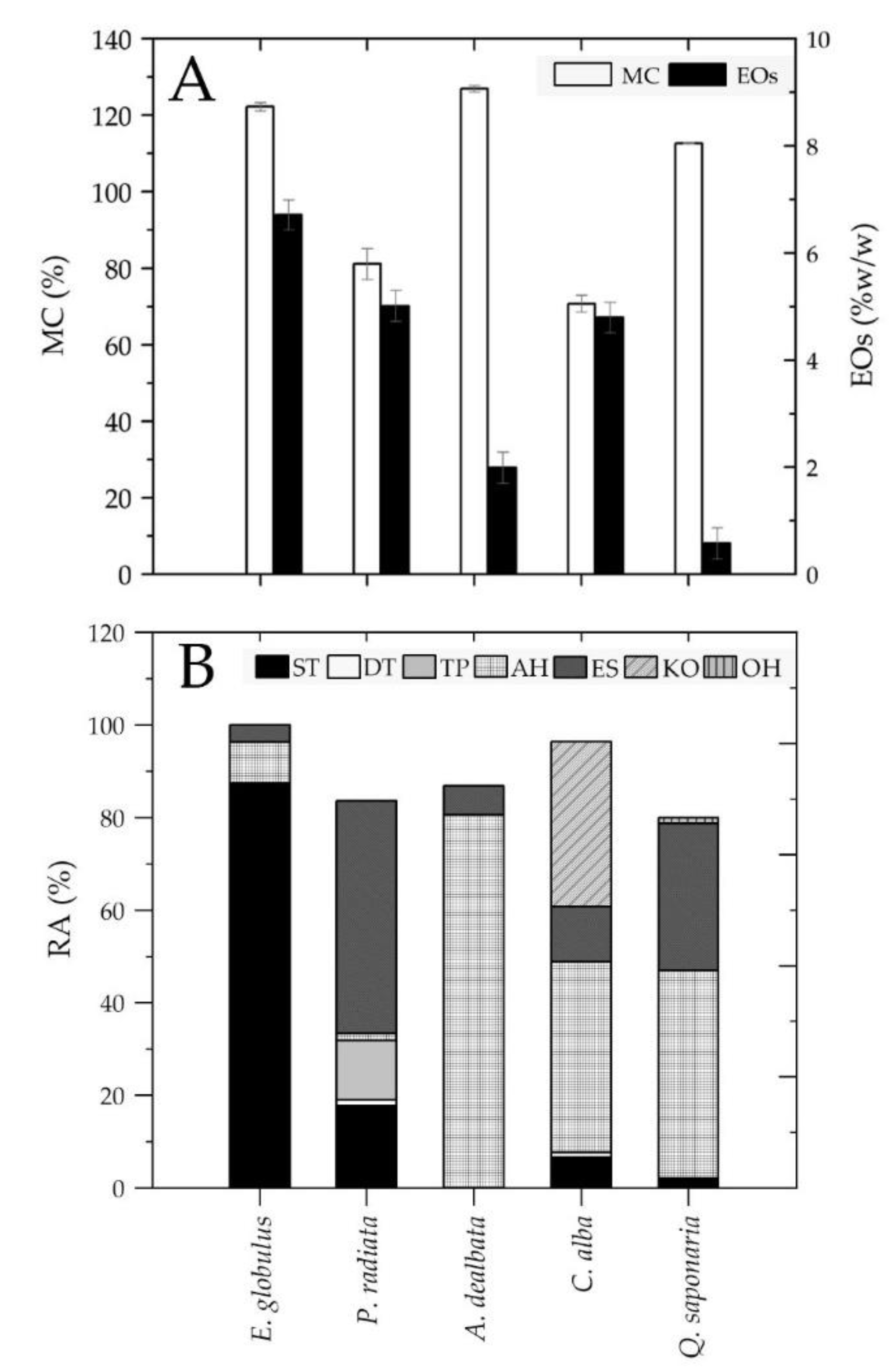
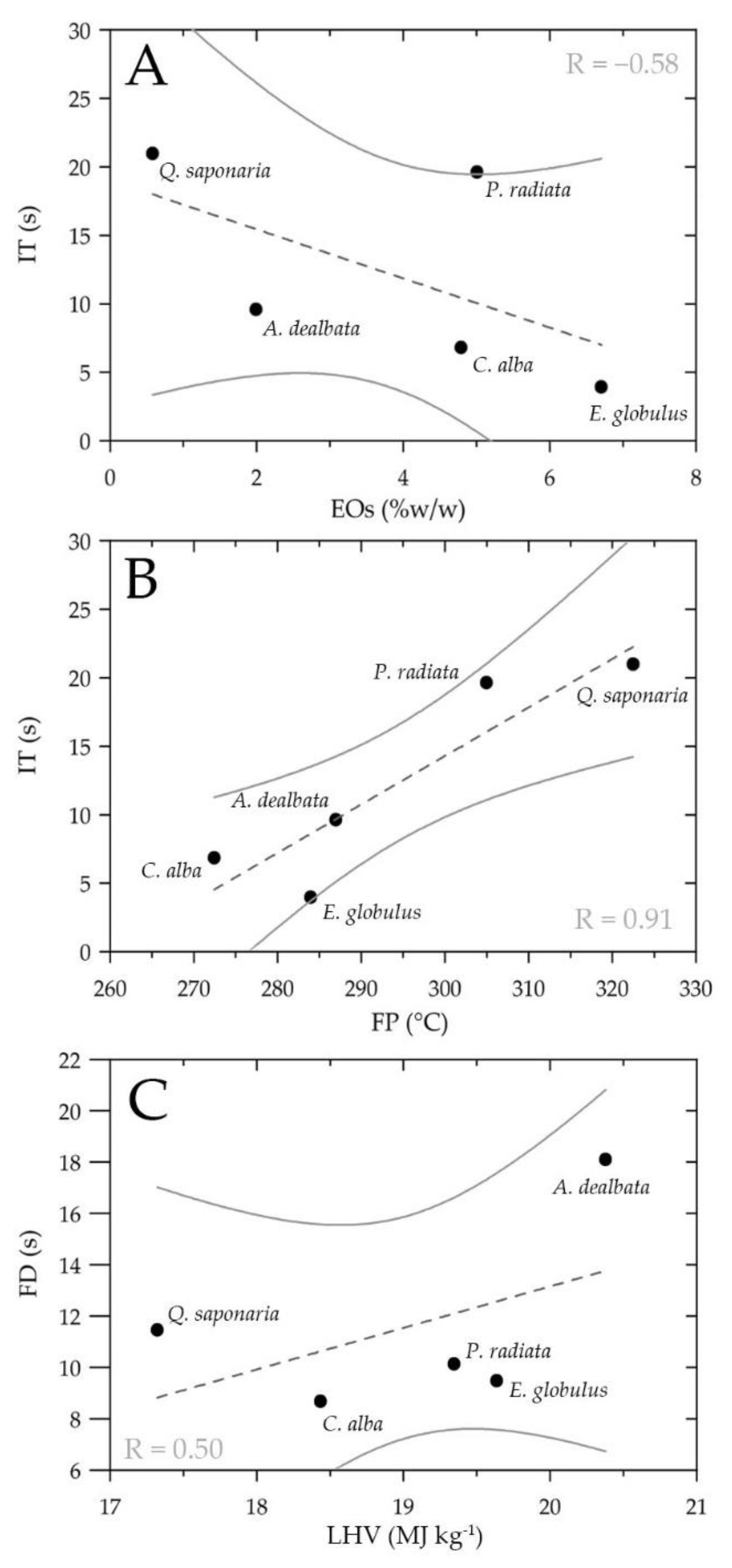
| IT (s) | Fr (%) | ||||
|---|---|---|---|---|---|
| 100–95 | 94–90 | 89–85 | 84–80 | < 50 | |
| < 12.5 | 5 | 4 | 3 | 3 | 1 |
| 12.5–17.5 | 4 | 3 | 3 | 2 | 1 |
| 17.5–22.5 | 3 | 3 | 2 | 2 | 0 |
| 22.5–27.5 | 3 | 2 | 2 | 1 | 0 |
| 27.5–32.5 | 3 | 2 | 2 | 1 | 0 |
| >32.5 | 3 | 1 | 2 | 0 | 0 |
| Species | IT (s) | Fr (%) | FI (-) | Classification |
|---|---|---|---|---|
| E. globulus | 3.98 ± 0.74 | 100 | 5 | Extremely flammable |
| C. alba | 6.85 ± 1.16 | 100 | 5 | Extremely flammable |
| A. dealbata | 9.65 ± 2.26 | 100 | 5 | Extremely flammable |
| P. radiata | 19.64 ± 3.08 | 100 | 3 | Flammable |
| Q. saponaria | 20.99 ± 6.09 | 100 | 3 | Flammable |
Publisher’s Note: MDPI stays neutral with regard to jurisdictional claims in published maps and institutional affiliations. |
© 2021 by the authors. Licensee MDPI, Basel, Switzerland. This article is an open access article distributed under the terms and conditions of the Creative Commons Attribution (CC BY) license (https://creativecommons.org/licenses/by/4.0/).
Share and Cite
Guerrero, F.; Hernández, C.; Toledo, M.; Espinoza, L.; Carrasco, Y.; Arriagada, A.; Muñoz, A.; Taborga, L.; Bergmann, J.; Carmona, C. Leaf Thermal and Chemical Properties as Natural Drivers of Plant Flammability of Native and Exotic Tree Species of the Valparaíso Region, Chile. Int. J. Environ. Res. Public Health 2021, 18, 7191. https://doi.org/10.3390/ijerph18137191
Guerrero F, Hernández C, Toledo M, Espinoza L, Carrasco Y, Arriagada A, Muñoz A, Taborga L, Bergmann J, Carmona C. Leaf Thermal and Chemical Properties as Natural Drivers of Plant Flammability of Native and Exotic Tree Species of the Valparaíso Region, Chile. International Journal of Environmental Research and Public Health. 2021; 18(13):7191. https://doi.org/10.3390/ijerph18137191
Chicago/Turabian StyleGuerrero, Fabián, Carla Hernández, Mario Toledo, Lorena Espinoza, Yulian Carrasco, Andrés Arriagada, Ariel Muñoz, Lautaro Taborga, Jan Bergmann, and Camilo Carmona. 2021. "Leaf Thermal and Chemical Properties as Natural Drivers of Plant Flammability of Native and Exotic Tree Species of the Valparaíso Region, Chile" International Journal of Environmental Research and Public Health 18, no. 13: 7191. https://doi.org/10.3390/ijerph18137191
APA StyleGuerrero, F., Hernández, C., Toledo, M., Espinoza, L., Carrasco, Y., Arriagada, A., Muñoz, A., Taborga, L., Bergmann, J., & Carmona, C. (2021). Leaf Thermal and Chemical Properties as Natural Drivers of Plant Flammability of Native and Exotic Tree Species of the Valparaíso Region, Chile. International Journal of Environmental Research and Public Health, 18(13), 7191. https://doi.org/10.3390/ijerph18137191






